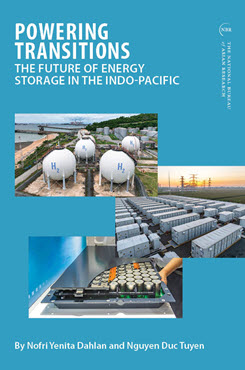Essay in NBR Special Report 119
Scaling Up Hydrogen Energy in the Indo-Pacific
This essay analyzes the current state of hydrogen technologies across the Indo-Pacific, highlighting national strategies, production capacities, and infrastructure development, and considers Vietnam as a case study of hydrogen development within the region.
EXECUTIVE SUMMARY
MAIN ARGUMENT
Hydrogen is becoming a key driver of decarbonization in major sectors like transportation, chemicals, and steel. As the Indo-Pacific accelerates its clean energy transition, hydrogen offers strong long-term potential. Yet most hydrogen today is still “gray” (produced from fossil fuels without carbon capture). In 2023, green hydrogen made up just 0.1% of global production. Scaling up the production of hydrogen energy across the Indo-Pacific is thus an urgent priority. Global players like the U.S. and China are already shaping hydrogen development through bold investments and policy support. The U.S. Inflation Reduction Act incentivized green hydrogen and fostered international cooperation, while China leads in infrastructure and capacity-building across Southeast Asia. Regional platforms such as the ASEAN Centre for Energy and the Asia Zero Emission Community are also aligning policies and facilitating knowledge transfer. Within this context, Vietnam offers a valuable case study for hydrogen development. The country has set an ambitious target of producing 10–20 million tonnes of hydrogen annually by 2050—equivalent to 10%–20% of current global output. While Vietnam currently lacks a fully developed hydrogen infrastructure, it has begun laying the groundwork to become a serious player in the regional hydrogen economy, particularly by leveraging offshore wind resources and emerging partnerships. With joint investment and coordinated strategies, the Indo-Pacific has a real opportunity to lead in building a sustainable hydrogen economy. Vietnam is poised to become a key regional player within this economy in the years ahead.
POLICY IMPLICATIONS
- As countries across the Indo-Pacific face mounting pressure to reduce emissions and strengthen energy security, green hydrogen offers a viable pathway to transition to clean energy—especially in hard-to-abate sectors such as steel, chemicals, and heavy transportation.
- To effectively develop hydrogen energy in the ASEAN region, member states could enhance regional cooperation by developing an integrated hydrogen roadmap and establishing a hydro training center, among other strategies and initiatives.
- Given Vietnam’s proactive policy direction, renewable energy potential, and international engagement, the country is well-positioned to become a leading force in the Indo-Pacific hydrogen economy and serve as a model for other developing countries.
Nguyen Duc Tuyen is an Associate Professor at Hanoi University of Science and Technology, as well as an Adjunct Associate Professor at Shibaura Institute of Technology. Dr. Nguyen was an NBR Clean EDGE Asia Fellow in 2022.


